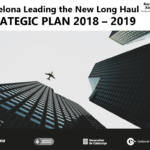
BARDC Strategic Plan 2018-2019: What is the overall economic impact of the Airport?
An increase of 10% in connectivity and number of frequencies is accompanied by an increase of 0.5% in the GDP of the region (ACI Europe, 2015). In Catalonia, this implies an approximate increase of € 1,000 M in the Catalan GDP for each 10% increase in connectivity at Barcelona Airport.
Connections created between cities and markets represent an important asset that generates benefits for the territory, facilitating communication, foreign direct investment, business groups, specialization, and other indirect impacts on the productive capacity of an economy; in addition to Tourism and the economic activity deriving from it (Cubela i Costa, 2013; Intervistas, 2014).
Air transport is the only mode of transport that allows the efficient exchange of tacit knowledge at a global level (Shin and Timberlake, 2000).
A 10% increase in the number of intercontinental direct flights results in a 4% increase in the location of business headquarters (Bel and Fageda, 2008).
More than 125,000 jobs * and over €7,600 m * of the Catalan GDP are linked to Barcelona Airport. The synergies of this infrastructure with nearby logistic hubs, the accessibility of the city as a business and tourism center, and its connection with Europe and the world are intimately linked to Barcelona-El Prat Airport. This relationship is growing over time, as it represents the link between Barcelona and the global economy. (Airport Development in the Delta Plan, BCN City Hall, 2016)
* Includes direct, indirect, induced and catalytic impact
Source: BARDC/April 2018
Barcelona Air Route Development Committee
promotes Barcelona Airport intercontinental flight








